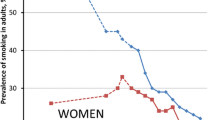Abstract
Tobacco use is a modifiable risk factor that has many characteristics of a chronic illness. We analyzed longitudinal data from participants in the Atherosclerosis Risk in Communities Study (ARIC) and the Cardiovascular Health Study (CHS) and compared tobacco use to other chronic illnesses to evaluate effects on mortality. We limited our analysis to 20,293 participants aged 45 and older at baseline. We determined smoking status, diabetes status, hypertension, cardiovascular disease (ASCVD), and lung disease status at baseline. We developed Cox proportional hazard models, adjusting for age, sex and race and all comorbid diseases, to determine the effect of disease on mortality at up to 13 years of follow-up, 3,022 study participants died during the follow-up period. Adjusted proportional hazard models found that the risk of smoking for death had a hazard ratio (HR) of 2.0 (95% confidence interval [CI] 1.8, 2.2). This was similar to the mortality risk for ASCVD (HR 1.8, 95% CI 1.7, 2.0), diabetes (HR 1.9, 95% CI 1.7, 2.0), and chronic obstructive pulmonary disease (COPD) (HR 2.1, 95% CI 1.9, 2.4). The risk in former smokers were significantly less than that of current smokers (HR 1.1, 95% CI 1.01, 1.2). In the adjusted models, current cigarette smoking has a mortality risk that is in the same range of that seen in other “chronic diseases”, whereas the risk in former smokers is greatly reduced. These data suggest that current smoking should be approached as aggressively as other chronic diseases that are amenable to interventions.


Similar content being viewed by others
References
Centers for Disease Control and Prevention. (2004). Indicators for chronic disease surveillance. MMWR Recommendations and Reports, 53, 1–6.
Lee, C., & Kahende, J. (2007). Factors associated with successful smoking cessation in the United States, 2000. American Journal of Public Health, 97, 1503–1509.
American Heart Association. (2007). Cardiovascular disease statistics. American Heart Association. http://www.americanheart.org/presenter.jhtml?identifier=4478.
Fiore, M. C., Croyle, R. T., Curry, S. J., Cutler, C. M., Davis, R. M., Gordon, C., et al. (2004). Preventing 3 million premature deaths and helping 5 million smokers quit: A national action plan for tobacco cessation. American Journal of Public Health, 94, 205–210.
American Cancer Society. (2007). Prevention and early detection: Cigarette smoking. American Cancer Society. http://www.cancer.org/docroot/PED/content/PED_10_2x_cigarette_smoking.asp.
Enright, P. L., Kronmal, R. A., Higgins, M. W., Schenker, M. B., & Haponik, E. F. (1994). Prevalence and correlates of respiratory symptoms and disease in the elderly. Cardiovascular health study. Chest, 106, 827–834.
Gritz, E. R., Vidrine, D. J., & Fingeret, M. C. (2007). Smoking cessation a critical component of medical management in chronic disease populations. American Journal of Preventive Medicine, 33, S414–S422.
Li, R., Folsom, A., Sharrett, A. R., Couper, D., Bray, M., & Tyroler, H. A. (2001). Interaction of the glutathione S-transferase genes and cigarette smoking on risk of lower extremity arterial disease: The atherosclerosis risk in communities (ARIC) study. Atherosclerosis, 154, 729–738.
Wattanakit, K., Folsom, A. R., Chambless, L. E., & Nieto, F. J. (2005). Risk factors for cardiovascular event recurrence in the atherosclerosis risk in communities (ARIC) study. American Heart Journal, 149, 606–612.
Kaur, J., Singh, P., & Sowers, J. R. (2002). Diabetes and cardiovascular disease. American Journal of Therapeutics, 9, 510–515.
Kuller, L. H., Velentgas, P., Barzilay, J., Beauchamp, N. J., O’Leary, D. H., & Savage, P. J. (2000). Diabetes mellitus: Subclinical cardiovascular disease and risk of incident cardiovascular disease and all-cause mortality. Arteriosclerosis, Thrombosis, and Vascular Biology, 20, 823–829.
Anthonisen, N. R. (2005). The effects of a smoking cessation intervention on 14.5-year mortality—response. Annals of Internal Medicine, 143, 615.
Schroeder, E. B., Welch, V. L., Evans, G. W., & Heiss, G. (2005). Impaired lung function and subclinical atherosclerosis. The ARIC study. Atherosclerosis, 180, 367–373.
Mannino, D. M., Doherty, D. E., & Buist, A. S. (2006). Global initiative on obstructive lung disease (GOLD) classification of lung disease and mortality: Findings from the atherosclerosis risk in communities (ARIC) study. Respiratory Medicine, 100, 115–122.
Atherosclerosis risk in communities study: Community surveillance and cohort morbidity/mortality follow-up manual 1 general description and study management version 5.0. (2006).
Atherosclerosis risk in communities study. University of North Carolina School of Public Health. (2008).
Rabe, K. F., Hurd, S., Anzueto, A., Barnes, P. J., Buist, S. A., Calverley, P., et al. (2007). Global strategy for the diagnosis, management, and prevention of chronic obstructive pulmonary disease: GOLD executive summary. American Journal of Respiratory and Critical Care Medicine, 176, 532–555.
Rijken, M., van Kerkhof, M., Dekker, J., & Chellevis, F. G. (2005). Comorbidity of chronic diseases: Effects of disease pairs on physical and mental functioning. Quality of Life Research, 14, 45–55.
Li, R. L., Boerwinkle, E., Olshan, A. F., Chambless, L. E., Pankow, J. S., Tyroler, H. A., et al. (2000). Glutathione S-transferase genotype as a susceptibility factor in smoking-related coronary heart disease. Atherosclerosis, 149, 451–462.
Khurana, S., Batra, V., Patkar, A. A., & Leone, F. T. (2003). Twenty-first century tobacco use: It is not just a risk factor anymore. Respiratory Medicine, 97, 295–301.
Olshan, A. F., Li, R., Pankow, J. S., Bray, M., Tyroler, H. A., Chambless, L. E., et al. (2003). Risk of atherosclerosis: Interaction of smoking and glutathione S-transferase genes. Epidemiology, 14, 321–327.
Acknowledgments
This work was funded by a research grant from Pfizer.
Disclosure Statement
Dr. Mannino has received research grants from GlaxoSmithKline, Pfizer, and Novartis and serves as a consultant to GlaxoSmithKline, Pfizer, Boehringer-Ingelheim, Astra-Zeneca, Dey, Sepracor, and Novartis.
Author information
Authors and Affiliations
Corresponding author
Rights and permissions
About this article
Cite this article
Hudson, N.L., Mannino, D.M. Tobacco Use: A Chronic Illness?. J Community Health 35, 549–553 (2010). https://doi.org/10.1007/s10900-010-9241-x
Published:
Issue Date:
DOI: https://doi.org/10.1007/s10900-010-9241-x




